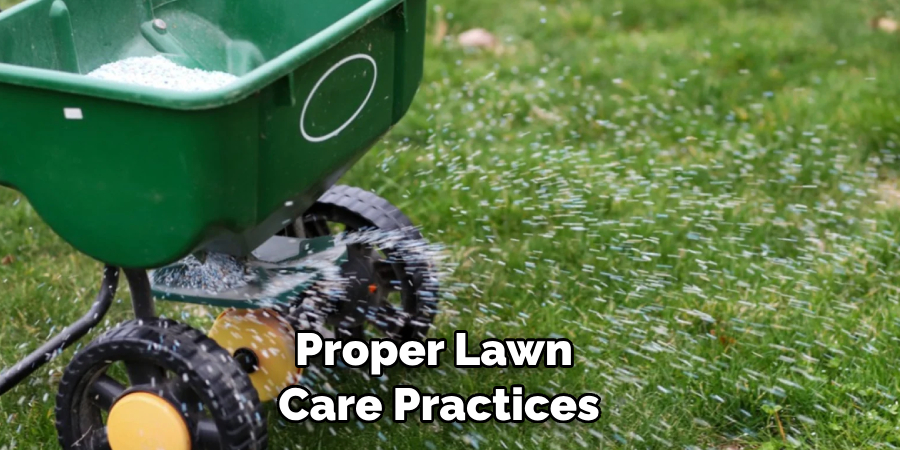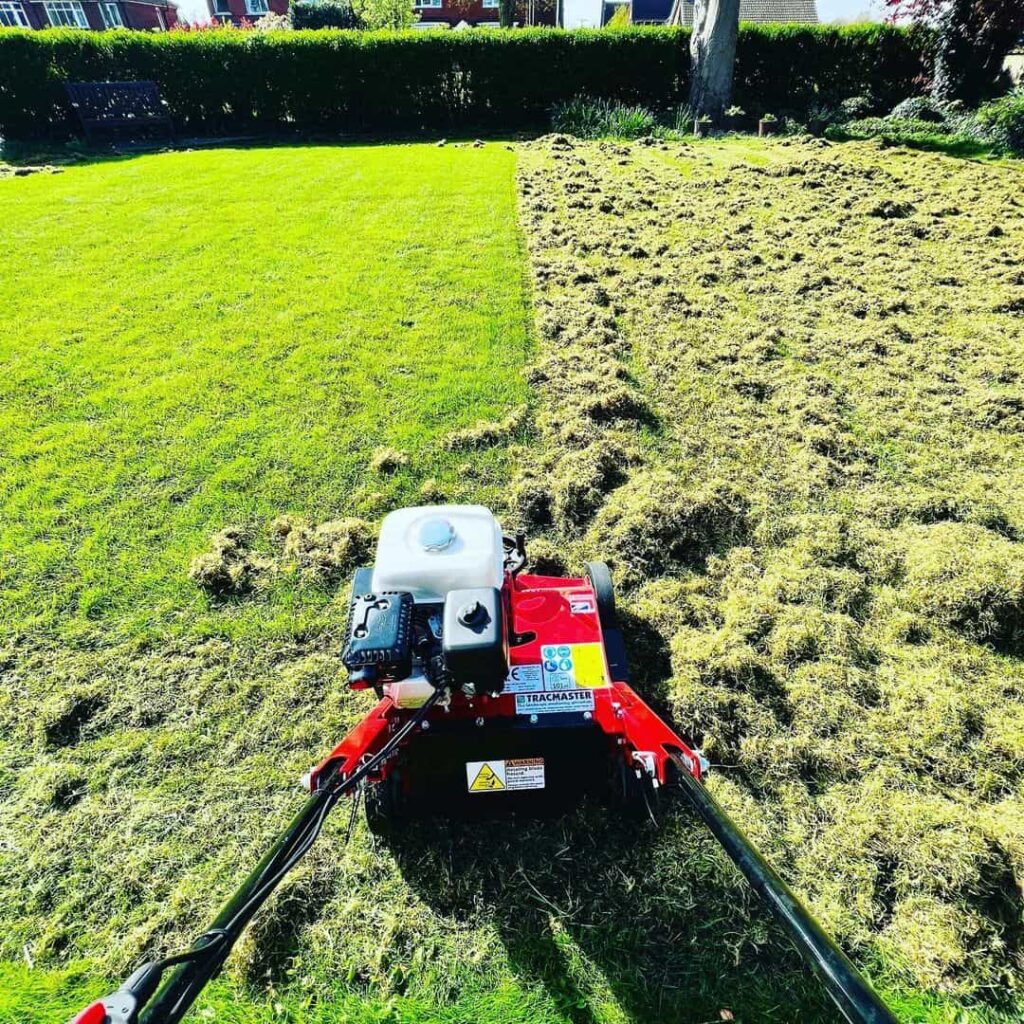Reviving a lawn after scarifying requires reseeding and proper watering to promote healthy regrowth. A well-maintained and lush lawn can significantly enhance the aesthetic appeal of any outdoor space.
However, over time, lawns can become compacted, with excessive thatch and moss buildup, leading to a lackluster appearance. Scarifying, also known as lawn raking, is a process that involves removing these unwanted elements to allow new grass growth. While scarifying is beneficial for long-term lawn health, it can leave the surface in need of some revival.
To restore your lawn’s vitality, reseeding and adequate watering are paramount. This article will guide you through the steps necessary to revive your lawn after scarifying, ensuring that it regains its lush and vibrant green color.

Credit: simsgardenmachinery.co.uk
Why Scarifying Is Essential For Lawn Health
Scarifying is essential for lawn health because it removes thatch build-up. Thatch can hinder water and nutrient absorption, affecting your lawn’s overall health. Scarifying also promotes air circulation, which is vital for healthier grass growth. By allowing air to reach the grass’ roots, scarifying prevents disease and weed infestation.
It’s essential to remember that a healthy lawn requires regular scarifying to maintain its vigor and vitality. So, if you want to revive your lawn after scarifying, follow these steps diligently. First, rake or use a scarifying machine to remove the thatch.
Then, aerate the soil to improve air circulation and water absorption. Finally, overseed and fertilize, ensuring the grass receives the necessary nutrients for rapid growth. With proper scarifying and care, your lawn will thrive and be the envy of the neighborhood.
Preparing Your Lawn For Scarifying
To successfully revive a lawn after scarifying, start by preparing it properly. Identifying the right time and climate conditions for scarifying is crucial. Next, mow the lawn to the recommended height to ensure an even cut. Additionally, it is important to remove any debris or obstacles from the lawn, such as fallen branches or toys.
This will allow for a thorough and effective scarifying process. By following these steps, you can revive your lawn and promote healthy growth. So, take the time to prepare your lawn before scarifying to achieve the best results.
Step-By-Step Guide To Scarifying Your Lawn
To revive your lawn after scarifying, follow this step-by-step guide. First, choose the appropriate scarifying equipment. Next, adjust the scarifier settings to the right depth. Then, scarify the lawn in parallel passes, covering the entire area. Make sure to collect and remove the resulting thatch.
By following these instructions, your lawn will be on its way to a healthy and lush revival. Remember, choosing the right equipment and adjusting the settings are crucial for successful scarifying. So, take your time and ensure you cover the entire lawn evenly.
Once you’ve collected the thatch, dispose of it properly. Reviving your lawn after scarifying might take some effort, but the end result will be worth it. Start the process today for a beautiful and vibrant lawn.
Understanding The Effects Of Scarifying On Your Lawn
Understanding the effects of scarifying on your lawn includes recognizing the initial stress placed on the grass and how it recovers. After scarifying, it’s common to see temporary brown patches and thinning, which can be expected. Assessing the impact on weed growth and disease pressure is also essential.

Overall, proper lawn care practices like watering and fertilizing can help the grass recover from scarifying, allowing it to regain its green and healthy appearance. It’s crucial to be patient and allow time for the grass to rejuvenate naturally without the need for additional intervention or treatment.
Following these steps will help revive your lawn and maintain its beauty and vitality.
Watering And Feeding Your Lawn After Scarifying
After scarifying your lawn, adequate watering is crucial for promoting recovery and growth. Remember to water your lawn regularly, but avoid overwatering. Applying a balanced fertilizer is another important step to provide your lawn with the necessary nutrients. Make sure to choose a fertilizer that contains the right amounts of nitrogen, phosphorus, and potassium.
However, be cautious and avoid excessive nitrogen application, as this can lead to rapid growth but weak roots. It’s best to follow the instructions provided by the manufacturer when applying the fertilizer. By following these practices, you can help your lawn revive and flourish, creating a beautiful and healthy outdoor space.
So, remember to water and feed your lawn appropriately after scarifying.
Overcoming Common Challenges After Scarifying
After scarifying your lawn, common challenges may arise, such as potential weed invasion. To overcome this, strategies should be implemented to encourage grass re-growth. Additionally, it is essential to address any pest or disease issues that may hinder the revival process.
By focusing on these key aspects, you can ensure the successful recovery of your lawn. Implementing appropriate weed control measures, like regular mowing and applying herbicides, can prevent weed invasion and promote healthy grass growth. Furthermore, paying attention to signs of pest or disease infestation and promptly taking appropriate action, like using insecticides or fungicides, can prevent further damage.
By following these techniques, you can revive your lawn and create a lush, green landscape.
Frequently Asked Questions For How To Revive A Lawn After Scarifying
How Soon Can I Reseed My Lawn After Scarifying?
You should wait at least two weeks after scarifying your lawn before reseeding. This allows the grass to recover and gives the newly sown seeds the best chance of germinating and establishing strong roots.
Should I Water My Lawn After Scarifying?
Yes, it is essential to water your lawn after scarifying. This helps to alleviate any stress caused by the scarification process and aids in the recovery of the grass. Watering also ensures the soil remains moist, creating an ideal environment for new seed to grow.
Is It Necessary To Fertilize My Lawn After Scarifying?
Fertilizing your lawn after scarifying is highly recommended. Scarification can remove nutrients from the soil, so applying a balanced lawn fertilizer will help replenish these nutrients and support healthy grass growth. Be sure to choose a fertilizer specifically formulated for post-scarification use.
How Often Should I Mow My Lawn After Scarifying?
After scarifying, you should avoid mowing your lawn for at least two weeks to allow the grass to recover. Once you resume mowing, maintain a regular mowing schedule, aiming to mow no more than one-third of the grass blade’s height at a time to avoid stress on the newly growing grass.
Can I Walk On My Lawn After Scarifying?
It is best to avoid walking on your lawn for a few days after scarifying to allow the grass time to recover. Scarification can weaken the grass, so giving it a chance to rejuvenate without added pressure will enable optimal re-growth and help avoid further damage.
Conclusion
Reviving a lawn after scarifying may seem like a daunting task, but with the right approach, it can yield fantastic results. Firstly, ensure you have scarified your lawn correctly, removing thatch and debris to encourage healthy growth. Following scarification, overseed the lawn to fill in any bare patches and improve density.
Choosing the right grass seed for your climate and soil type is crucial for success. Watering the lawn adequately and regularly is important to promote germination and establishment of the new grass. Adjusting your mowing and maintenance practices to suit the newly revived lawn will help maintain its health and appearance.
Finally, incorporating proper fertilization and weed control measures into your lawn care routine will contribute to its long-term vitality. By following these steps, you’ll be well on your way to a beautiful, green lawn that you can enjoy year-round.

